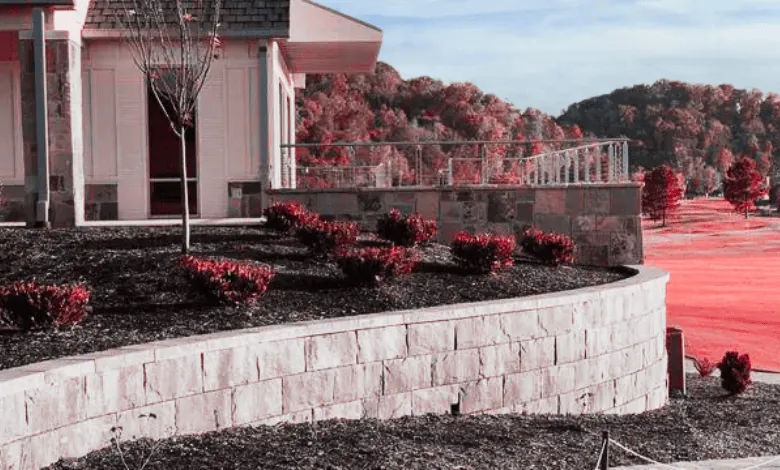Backyard Bliss: How a Wood Retaining Wall Can Transform Your Space

Do you want to make the most of your backyard space? A wood retaining wall can help you create a stunning outdoor area that is both functional and beautiful. Whether you want to create a cozy patio, a lush garden, or a fire pit area, a wood retaining wall can help you achieve your backyard goals.
Understanding Retaining Walls
A retaining wall is more than just a decorative feature in your backyard. It’s a smart way to protect your soil and create more usable space for your outdoor activities. A retaining wall is a structure that holds back soil or water, creating different levels of elevation in your landscape. This way, you can prevent erosion, drainage problems, and slope instability that can damage your property and plants. A retaining wall also allows you to create level areas for various purposes, such as a patio, a garden, or a fire pit. You can enjoy more comfort and convenience in your backyard with a retaining wall.
Why Choose Wood for Your Retaining Wall
While there are many options available, such as concrete, stone, brick, or metal, none of them can match the charm and appeal of wood. Here are some reasons why you should choose wood for your retaining wall.
- Wood is a natural and renewable resource that blends well with the environment. It adds a touch of warmth and coziness to your backyard, creating a welcoming and relaxing atmosphere for you and your guests.
- Wood is also a versatile material that can be shaped, cut, stained, or painted to suit your preferences and style. You can choose from different types of wood, such as cedar, pine, redwood, or pressure-treated lumber, depending on your budget and durability needs.
- Wood allows you to customize your retaining wall with various design features, such as curves, steps, planters, benches, or lighting. You can also add decorative elements, such as stones, tiles, or metal accents, to enhance the look and functionality of your wall.
Types of Wood for Retaining Walls
Here are some of the most common types of wood for retaining walls and their pros and cons.
- Pressure-treated lumber: This is the most popular choice for wood retaining walls because it’s affordable, easy to find, and resistant to rot and insects. However, it also has some drawbacks, such as warping, cracking, and leaching chemicals into the soil. You’ll need to seal and stain it regularly to maintain its appearance and durability.
- Cedar: This is a natural and beautiful option that has a pleasant aroma and a rich color. It’s also naturally rot-resistant and insect-repellent, so you don’t need to treat it with chemicals. However, it’s also more expensive than pressure-treated lumber and can fade over time if exposed to sunlight. You’ll need to apply a clear finish or a UV-blocking stain to protect it from the elements.
- Redwood: This is another attractive and durable option that has a reddish-brown hue and a smooth texture. It’s also naturally rot-resistant and insect-repellent, and it doesn’t warp or crack as much as pressure-treated lumber. However, it’s also very expensive and hard to find, especially in larger sizes. You’ll need to apply a clear finish or a UV-blocking stain to protect it from the elements as well.
DIY or Hire a Contractor
If you’ve read this far, you might be thinking of having a wood retaining wall. But how do you go about building one? Should you do it yourself or hire a contractor? Here are some things to consider before you decide.
One option is to take on the project as a DIY challenge. Building a wood retaining wall can be a rewarding experience that allows you to customize your design and save money on labor costs. However, it also requires careful planning and execution. You’ll need to choose the right materials, prepare the site, dig the foundation, install the posts, cut and attach the boards, and backfill the wall with gravel and soil. You’ll also need to follow the local building codes and regulations, and make sure your wall is stable and durable. If you have the skills, tools, and time for this task, then go for it!
Another option is to hire a professional contractor who can do the job for you. A contractor will have the expertise and experience to build a wood retaining wall that meets your needs and expectations. They will also save you time and hassle, as they will handle everything from design to installation. Plus, they will ensure that your wall is built with quality materials and techniques, and that it complies with the safety standards. Hiring a contractor might cost more upfront, but it can also give you peace of mind and a long-lasting result.
Maintaining Your Wood Retaining Wall
To keep your wood retaining wall looking great and lasting long, you need to take good care of it. Here are some tips on how to maintain it.
Clean it regularly. Dirt, dust, and debris can accumulate over time, making it look dull and dirty. You can use a soft-bristled brush or a garden hose to gently remove any dirt or stains. You can also use a mild detergent or a wood cleaner to wash your wood retaining wall, but make sure to rinse it well with water afterwards.
Seal periodically. Wood is a natural material that can be affected by moisture, sunlight, and insects. To protect your wood retaining wall from these elements, you need to apply a sealant or a stain every few years. A sealant or a stain can enhance the color and texture of your wood retaining wall, as well as prevent water damage, fading, cracking, and warping. You can choose from different types of sealants or stains, depending on the look and finish you want.
Inspect for any damage or rot. Even with proper cleaning and sealing, your wood retaining wall may still suffer from some wear and tear over time. To ensure safety and stability, you need to inspect it for any signs of damage or rot at least once a year. Look for any loose or missing boards, nails, or screws, as well as any cracks, splits, holes, or decay. If you find any damage or rot, you need to repair or replace the affected parts as soon as possible.
Conclusion
A wood retaining wall can transform your backyard space in many ways. It can create more usable land, prevent soil erosion, improve drainage, and add visual interest. It can also complement any style of home, from rustic to modern. Whether you want to create a cozy fire pit, a raised garden bed, or a multi-level patio, a wood retaining wall can help you achieve your dream backyard.
If you are looking for a versatile and aesthetically pleasing option for your landscaping projects, consider a wood retaining wall. You will be amazed by the difference it can make in your outdoor living space. A wood retaining wall is not only functional, but also beautiful and durable. It can enhance the value and appeal of your home for years to come.
Explore more insights and discover a world of possibilities – check out now!






